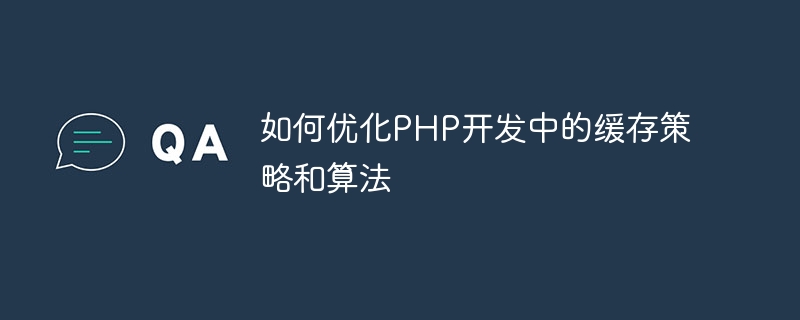Home >Backend Development >PHP Tutorial >How to optimize caching strategies and algorithms in PHP development
How to optimize caching strategies and algorithms in PHP development
- WBOYWBOYWBOYWBOYWBOYWBOYWBOYWBOYWBOYWBOYWBOYWBOYWBOriginal
- 2023-10-08 09:12:311686browse

How to optimize caching strategies and algorithms in PHP development
Caching is one of the important means to improve the performance of Web applications, and in PHP development, optimizing caching strategies and algorithms Algorithms are the key to improving Web application performance. This article will introduce some methods to optimize caching strategies and algorithms in PHP development, and give specific code examples.
1. Choose the appropriate caching algorithm
In PHP development, common caching algorithms include least recently used (LRU), first in first out (FIFO), most recently used (LFU), etc. Choosing an appropriate caching algorithm can improve the cache hit rate and thereby improve Web application performance.
For example, use the LRU algorithm to implement a cache class:
class LRUCache {
private $capacity;
private $cache;
public function __construct($capacity) {
$this->capacity = $capacity;
$this->cache = [];
}
public function get($key) {
if (isset($this->cache[$key])) {
$value = $this->cache[$key];
unset($this->cache[$key]);
$this->cache[$key] = $value;
return $value;
} else {
return -1;
}
}
public function put($key, $value) {
if (isset($this->cache[$key])) {
unset($this->cache[$key]);
} else {
if (count($this->cache) >= $this->capacity) {
array_shift($this->cache);
}
}
$this->cache[$key] = $value;
}
}2. Set the cache time reasonably
In actual applications, different data may have different update frequencies. For data that is updated frequently, the cache time can be set shorter to ensure the real-time nature of the data. For data that is updated less frequently, the cache time can be set longer to improve the cache hit rate.
For example, set up a cache class to dynamically adjust the cache time according to the data update frequency:
class DynamicCache {
private $cache;
private $expiration;
public function __construct() {
$this->cache = [];
$this->expiration = [];
}
public function get($key) {
if (isset($this->cache[$key]) && time() < $this->expiration[$key]) {
return $this->cache[$key];
} else {
return null;
}
}
public function put($key, $value, $expiration) {
$this->cache[$key] = $value;
$this->expiration[$key] = time() + $expiration;
}
}3. Use multi-level cache
For web applications with high performance requirements , you can use multi-level caching strategies. Specifically, data can be cached in an in-memory cache server (such as Redis, Memcached), and part of the data can be cached in the file system.
For example, use Redis as the first-level cache and cache the data in the file system as the second-level cache:
class MultiLevelCache {
private $redis;
private $fileCache;
public function __construct() {
$this->redis = new Redis();
$this->redis->connect('127.0.0.1', 6379);
$this->fileCache = new FileCache();
}
public function get($key) {
$value = $this->redis->get($key);
if ($value === false) {
$value = $this->fileCache->get($key);
if ($value !== null) {
$this->redis->set($key, $value);
$this->redis->expire($key, 3600);
}
}
return $value;
}
public function put($key, $value) {
$this->redis->set($key, $value);
$this->redis->expire($key, 3600);
$this->fileCache->put($key, $value);
}
}In summary, optimizing the caching strategy and algorithm in PHP development is to improve Important approach to web application performance. By selecting appropriate caching algorithms, setting cache time reasonably, and using multi-level caching strategies, cache hit rates and data reading speeds can be effectively improved, thereby improving the performance and user experience of web applications.
(Note: The above code examples are for reference only, and the specific implementation needs to be adjusted and optimized according to actual needs.)
The above is the detailed content of How to optimize caching strategies and algorithms in PHP development. For more information, please follow other related articles on the PHP Chinese website!

